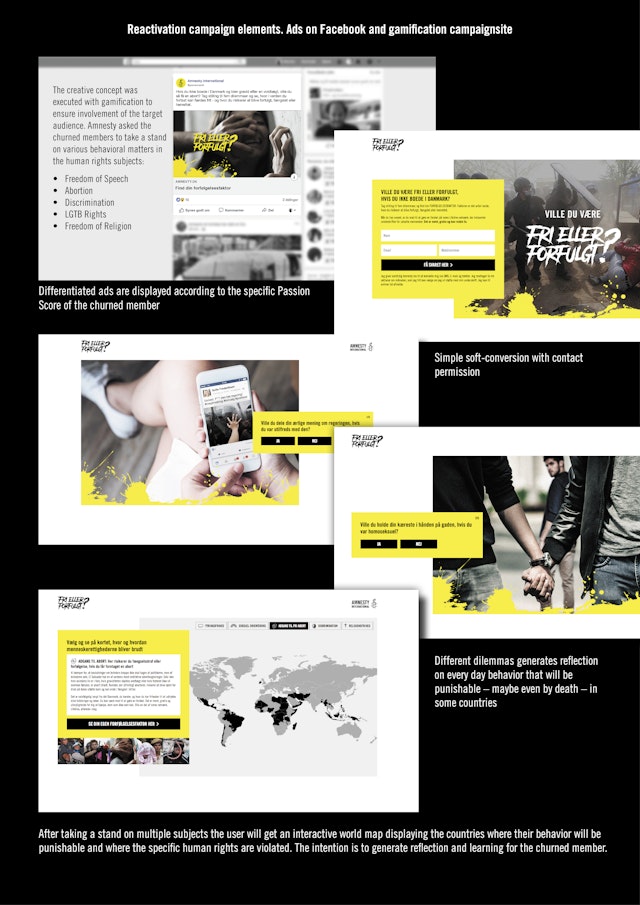Here’s how Amnesty International Denmark re-engaged former members
Ambition won the ‘Not-for-profit/Charity’ category at The Drum Awards for the Digital Industries 2021. Here, the team behind the winning entry reveal the secrets of this successful project...
The challenge
As a non-profit organization Amnesty International works in many different areas of human rights, which is an opportunity because of broader appeal but also a challenge since relevance of separate causes may be less clear for the individual member. In recent years, Amnesty International in Denmark has been losing members and attempts to re-engage them have not been very successful. The purpose of this campaign was to reactivate and re-enlist churned members through a data driven strategy.
The campaign aimed to reactivate 80,000 churned members and make them reflect on the great and important work that Amnesty do across the world. The aim was to activate 10% of the target audience and involve them in the campaign.
Several interaction based KPIs were set up to support this overall objective. The ultimate goal and KPI of the campaign was to get as many churned members possible to join Amnesty as a member again. The point of breakeven for the campaign was 500 members.
This was based on the estimated lifetime value of a member but divided by three, since there was not enough data volume for the value of a rejoined member. The second most important KPI was a softer conversion for LifeLine, which is Amnesty’s SMS based petition network, and the aim was set to get 15% of the involved to give their full contact permission and join LifeLine.
The strategy
One data driven insight was that activation of members and attempts to reactivate churned members had worked poorly with a general Amnesty perspective. So we needed to become much more relevant for the individual, which resulted in the development of ’The Passion Score’ – scoring churned member’s individual passion(s) to communicate extremely relevant. The campaign built on this scoring to reactivate churned members and get them to join Amnesty again, and it was a historical success for Amnesty on all KPIs.
The strategy was to use data driven insights to enable successful reactivation of churned members. These actionable data driven insights were built on transactional data and behavioral data. A combination of the members’ and former members’ historical transactions as well as how they have interacted with Amnesty across channels. From Amnesty’s various systems we had the base data and transactional data and we enriched with third-party data for demographics.
We also had the data for website and e-mail interaction as well as the interaction with LifeLine, Amnesty’s SMS based petition network. The key insight was that Amnesty’s members have various and very different reasons for becoming a member, since Amnesty work in many different areas of human rights. It is not a given that you will be equally interested in ‘freedom of speech’ and ‘democracy’, if you have joined on the basis of your interest in ‘Women’s rights’.
So we developed several scoring models, eg ‘churn scores’ and ‘membership value/potential scores’, but also the very powerful ’Passion Score’, which would identify the subjects for which any specific member or previous member was most passionate about. We developed prediction models that learned from the interaction of the previous members in a set of machine learning algorithms. This data driven insights and scoring enabled Amnesty to become extremely relevant for each individual in an automated cross channel campaign.

The campaign
The creative strategy was to confirm the relevance of the work done by Amnesty for each churned member based on individual passions. The creative concept was executed with gamification to ensure involvement of the target audience. Amnesty asked the churned members to take a stand on various behavioral matters in the human rights subjects eg ‘Freedom of Speech’, ‘Abortion’, ‘Discrimination’, ‘LGTB Rights’ and ‘Freedom of Religion’.
Data even played a role in the creative execution where each involved individual would have their ‘Persecution factor’ calculated based on their replies. The factor is based on the number of countries across the world where you would be persecuted – depending on your replies.
The Messaging spoke directly to the passions, and the work of Amnesty and we tested multiple clear calls for action during the campaign. With the scoring of the churned members we could target them with messaging for their individual passion(s) in touchpoints as social media, display banners, email and even for potential high value members with direct mail, and drive them to the campaign microsite to involve in the gamification.
The results
The campaign was a historic success for Amnesty on all major KPIs. On only the first wave of the campaign – running for approximately five months - we reactivated 12,000 (15%) of the total target audience of 80,000 churned members making the fight for human rights more present for them. We made more than 3,100 people sign up for the LifeLine network and grant their full contact permission to Amnesty, a total over-performance of 258%.
First and foremost, the first wave alone made more than half of the converted sign up as a full member of Amnesty again. Several more waves have run with comparable results and now both the scoring models and the campaign has also found use in both membership activation and retention, as well as membership enlistments efforts.
This project was a winner at The Drum Awards for the Digital Industries 2021. Find out which of The Drum Awards are currently open for entry.
Content created with:

Ambition
Find out more
